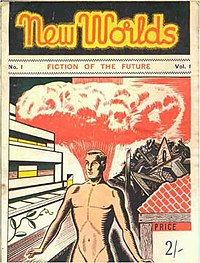 First issue cover, 1946 | |
| Categories | Science fiction magazine |
|---|---|
| First issue | 1936 |
| Country | United Kingdom |
| Based in | London |
| Language | English |
New Worlds was a British science fiction magazine that began in 1936 as a fanzine called Novae Terrae. John Carnell, who became Novae Terrae's editor in 1939, renamed it New Worlds that year. He was instrumental in turning it into a professional publication in 1946 and was the first editor of the new incarnation. It became the leading UK science fiction magazine; the period to 1960 has been described by science fiction historian Mike Ashley as the magazine's "Golden Age".[1]
Carnell joined the British Army in 1940 following the outbreak of the Second World War and returned to civilian life in 1946. He negotiated a publishing agreement for the magazine with Pendulum Publications, but only three issues of New Worlds were produced before Pendulum's bankruptcy in late 1947. A group of science fiction fans formed a company called Nova Publications to revive the magazine; the first issue under their management appeared in mid-1949. New Worlds continued to appear on a regular basis until issue 20, published in early 1953, following which a change of printers led to a hiatus in publication. In early 1954, when Maclaren & Sons acquired control of Nova Publications, the magazine returned to a stable monthly schedule.
Roberts & Vinter acquired New Worlds in 1964 when Michael Moorcock became editor. By the end of 1966, financial problems with their distributor led Roberts & Vinter to abandon New Worlds, but with the aid of an Arts Council grant obtained by Brian Aldiss, Moorcock was able to publish the magazine independently. He featured experimental and avant-garde material, and New Worlds became the focus of the "New Wave" of science fiction. Reaction among the science fiction community was mixed, with partisans and opponents of the New Wave debating the merits of New Worlds in the columns of fanzines such as Zenith-Speculation. Several of the regular contributors during this period, including Brian Aldiss, J. G. Ballard, Thomas M. Disch, and Moorcock himself, became major names in the field. By 1970, Moorcock was too in debt to continue with the magazine, and it became a paperback quarterly after issue 201. The title has been revived multiple times with Moorcock's direct involvement or approval; by 2021, 22 additional issues had appeared in various formats, including several anthologies.